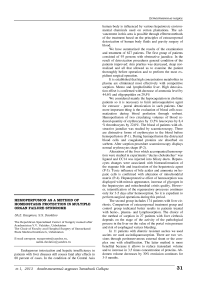Hemoperfusion as a method of homeostasis protection in multiple organ failure syndrome
Автор: Kasymov Sh.Z., Davlatov S.S.
Журнал: Академический журнал Западной Сибири @ajws
Рубрика: Хирургия. Онкология
Статья в выпуске: 1 (44) т.9, 2013 года.
Бесплатный доступ
Короткий адрес: https://sciup.org/140220838
IDR: 140220838
Текст статьи Hemoperfusion as a method of homeostasis protection in multiple organ failure syndrome
Endogenous intoxication and hepatic insufficiency in patients with liver diseases still couses fatal after effects in 80 percent of cases. In the condition of the Central Asia human body is influenced by various hepatotoxic environmental chemicals used on cotton plantations. The advancement in this area is possible through efferent methods of the treatment based on the principles of extracorporeal detoxication of human body fluids and gravity surgery of blood.
We have summarized the results of the examination and treatment of 627 patients. The first group of patients consisted of 93 persons with obstructive jaundice. In the result of detoxication procedures general condition of the patients improved: skin pruritus was decreased, sleep normalized and all that allowed us to examine the patient thoroughly before operation and to perform the most ex-pidient surgical operation.
It is established that high concentration metabolites in plasma are eliminated most effectively with competitive sorption. Memo and lympholirubin liver. High detoxication effect is confirmed with decrease of ammonia level by 44,6% and oligopeptides on 29,5%
We considered mainly the hypocaqutation in cholimic patients so it is necessary to limit anticoaqualative agent for extracor - poreal detoxication in such patients. One more important thing is the evaluation of blood cells traumatization during blood perfusion through sorbent. Hemoperfusion of two circulating volumes of blood reduced quantity of erythrocytes by 13,5% leucocytes by 8,4 % thrombocytes by 22,0%. The blood of patients with obstructive jaundice was studied by scanmicroscopy. There are distructive forms of erythrocytes in the blood before hemoperfusion (P-1). During hemoperfusion the distructed blood cells and coagulated proteins are absorbed on sorbent. After sorption procedure scanmicroscopy displays normal erythrocytes shape (P-2).
Alterations of the liver which accompanied hemosorption were studied in experiments "ductus choledochus" was ligated and CC14 was injected into biliary ducts. Hepatocytes changes were associated with biotransformation of the stagnate bile and inactivation of the hepatotoxic agent (P-3). Toxic influence of bile acides and ammonia on hepatic cells is confirmed with alteration of mitochondrial matrix (P-4). Hepatoprotective effect of hemosorption was displayed with mitosis appearance, increase of glycogen in the hepatocytes and mitochondrial cristis quality. However, intensification of the regeneratory processes continues only for 3-5 days after hemosorption. So it is expedient to perform surgical operations during this period.
The second group includes 174 patients with liver cirrhosis. Comparison of extracorporeal treatment group and control group indicated better results in patients treated with hemo-, plasma- and lymphosorption. The choice of the method of sorption in 27 patients with liver cirrhosis depends on the stage of the activity of the pathological process in the liver on the value of the portal vein pressure and risk of esophageal varices bleeding.
In 11 patients with diuretic resistant ascites we used ascites we used ascitoliquarosorption. There are two versions through peritoneovenous external shunt or the complex one with ultrafiltration. The latter method is more benefital because it allows to reduce transudant volume and to increase in 3,5 times concentration of proteins. Abdomen volume decreases by 30% remission continues for 3-5 months.
The third group includes 97 patients with distructive pancreatitis. Hemosorption was used in the period fermentative toxemia. Hemosorption reduced the acuteness pain in 61% of patients, normalized the hemodynamic disorders in 38% of patients and decreased hyperbilirubinemia in 30%.
The fourth group consists of 229 patients with peritonitis of various origin. We hove performed 163 hemosorptions in this group. The patients with severe ondoments intoxication favourable effect was registered in 62% unsignificant offect was in 2% and there were no changes registered in 17%. One lethal case was caused by prolonged peritonitis and undrained abscesses. However reduction of the toxic substances concentration in blood faciltated some after effects accompanied the sorption procedure: fever in 21%, thromboflebitis in 18%, thrombosis of the catheter in thoracic duct in 18%, collapse in 5%, hemorrage in 0,5%.


